Healthier Air for Students in Stockton, California
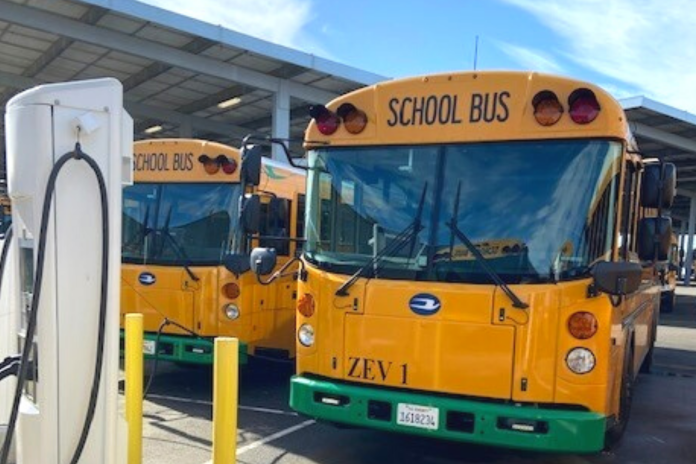
In collaboration with partners and communities, WRI’s Electric School Bus Initiative aims to build unstoppable momentum toward an equitable transition of the U.S. school bus fleet to electric, bringing health, climate and economic benefits to children and families across the country and normalizing electric mobility for an entire generation. The Electric School Bus Series shows how superintendents and fleet managers across the United States have pursued school bus electrification in their own communities. This edition covers Stockton Unified School District, California, which combined partnerships and state funding to kick-start their electrification efforts.
This piece is based off an interview with Gilbert Blue Feather Rosas, Energy Education Specialist for Stockton Unified School District.
The residents of Stockton Unified School District (SUSD), located in Northern California’s San Joaquin Valley, experience some of the highest asthma rates in the state, with California ranking Stockton in the 96th percentile for pollution burden and the 100th percentile for asthma. Stockton, which has 55 schools that serve about 40,000 students, was selected as a community to receive support under California’s AB 617 Community Air Protection Program, which focuses on reducing pollution exposure in communities most impacted by air pollution. SUSD also has high levels of poverty, with 78% of students eligible for free or reduced lunch.
Beginning in late 2019, SUSD partnered with Schneider Electric, the Center for Transportation and the Environment, Sage Energy Consulting, and The Mobility House to apply for the California Air Resources Board’s (CARB) Clean Mobility in Schools Project, seeing the conversion to electric school buses as a way to help improve air quality and protect student health. The partnership received $4.8 million in funding for four electric school buses, utility upgrades to the transportation yard, charging infrastructure for 24 buses and community outreach meetings. It also enabled SUSD to obtain permission from the Board of Education to begin converting their school bus fleet.
SUSD leveraged the CARB grant to secure additional sources of funding to cover phase one of the pilot, which required staff capacity to navigate the different application processes and bureaucratic requirements — a challenge many under-resourced school districts often lack capacity to undertake. SUSD received a $784,000 grant from the California Energy Commission, $1.89 million from the San Joaquin Valley Air Pollution Control District, $496,000 in utility rebates from Pacific Gas & Electric (PG&E) and $200,000 from a California Energy Commission Medium- and Heavy-Duty Zero-Emission Vehicle Infrastructure grant. In total, SUSD secured $8.3 million for 11 electric school buses and charging infrastructure (a mixture of DC fast and Level II chargers) for 24 buses in phase one of the pilot.
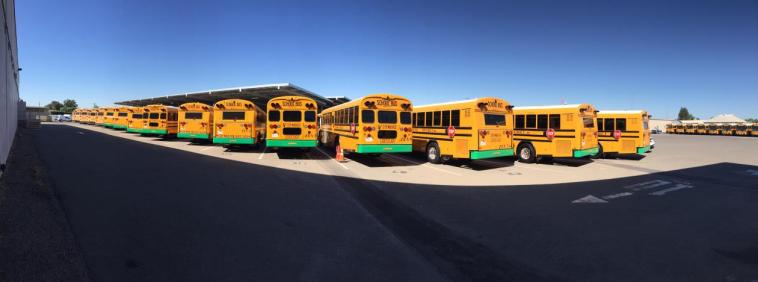
SUSD’s pilot moved extremely quickly despite COVID-19 budget cuts and constraints. SUSD received the initial CARB grant on January 7, 2020, had funds approved by April, broke ground on the bus charging infrastructure in September 2020 and had the charging infrastructure operational in December 2020. The team spent $4 million of the $4.8 million in CARB funding in the first year of the three-year grant. SUSD processed grant reimbursements through progress payments throughout the project, which reduced the impact on the school district’s budget.
Motivation & Co-Benefits:
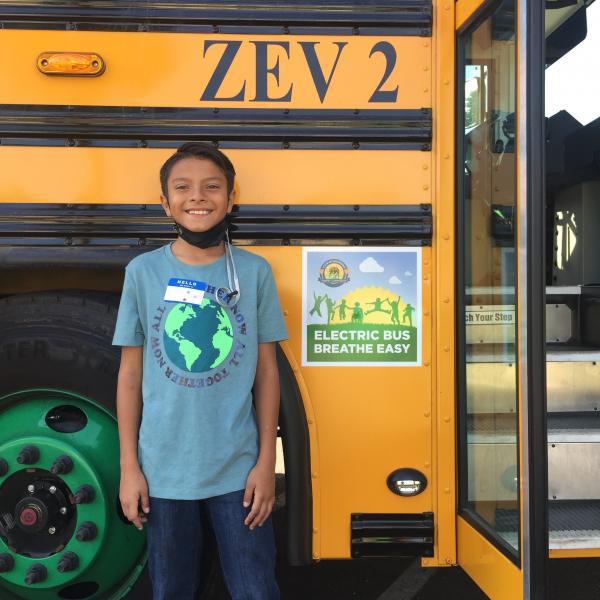
According to an interview with Gilbert (Gil) Rosas, SUSD’s Energy Education Specialist, in addition to focusing on the air quality benefits of electric school buses, SUSD engages students in clean energy projects to demonstrate that the green jobs of the future are for them. SUSD’s Energy Patrol is led by students and aims to educate teachers and students on how they can take action to help the school district become more energy efficient and save money on utility costs. Student-produced Energy Patrol videos are available in both English and Spanish. SUSD has also installed three solar arrays across the district’s facilities that produce about 551 kilowatts of energy.
Besides converting the school bus fleet from diesel to electric, SUSD is eager to explore potential vehicle-to-grid (V2G) benefits and setting up a charging center to provide backup power during emergencies, as the county experiences rolling blackouts during wildfires.
Partners:
In addition to working with the four partners for the CARB grant, SUSD partnered with their local utility, PG&E, and with Blue Bird and A-Z Bus Sales, the manufacturer and dealer of the first 11 buses. SUSD qualifies for PG&E’s Business Electric Vehicle rate, part of the utility’s EV Fleet Program. Little Manila Rising, a community-based organization in Stockton, is helping to set up air quality monitoring in the school district.
Pilot Status:
SUSD received its first 11 electric school buses at the end of May 2021, tested them over the summer with drivers and began using the new buses to transport students to school every day in August 2021. The electric school buses pick up students on the longest routes possible based on mileage to reduce emissions around students and the local community.
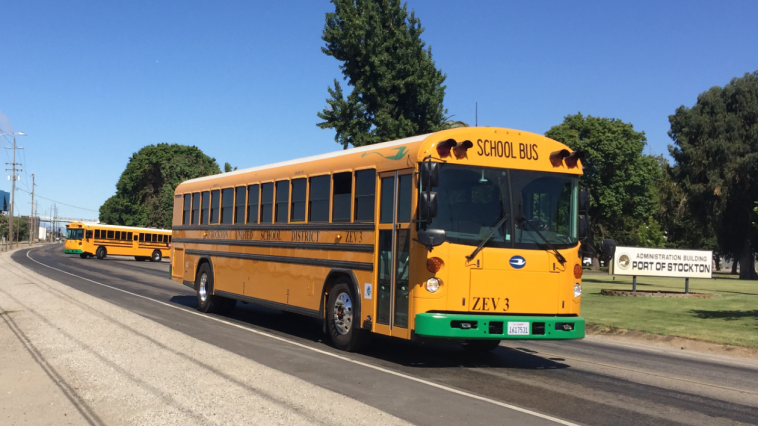
In October 2021, SUSD hosted a Clean Air Day event to allow students, families and staff to learn about air quality and interact with the new electric buses. The goal is to eventually convert all 96 of the school district’s buses, and SUSD is pursuing funding to procure an additional 10-20 electric school buses by the end of 2021.
Greatest Challenges in Setting Up the Pilot:
According to Rosas, the SUSD team was completely unfamiliar with electric school bus technology when they first started and had to do an enormous amount of research. However, Rosas — who has prior project management experience and an energy efficiency background — cites this lack of familiarity with ESB projects as a benefit, as no one told SUSD that they could not move as quickly with the project as they did. Upgrading the bus yard infrastructure was the most challenging aspect of the pilot so far.
The COVID-19 pandemic also created significant challenges, with budget cuts, staff layoffs and multiple leadership changes during the pilot.
Advice for Other School Districts:
Rosas believes that having a local champion and someone who is able to pursue an array of funding sources and engage with new technology is key. Though not all states have the same grant programs available as California, the recently enacted Infrastructure Investment and Jobs Act includes $2.5 billion in federal funding for electric school buses. In Rosas’ view, it’s also critical to bring in knowledgeable partners who will support the pilot and walk fleet managers through the myriad technical aspects of procuring electric school buses and setting up charging infrastructure. Though the technology can be overwhelming, Rosas advises just getting started and learning from the experiences of school districts like Stockton.
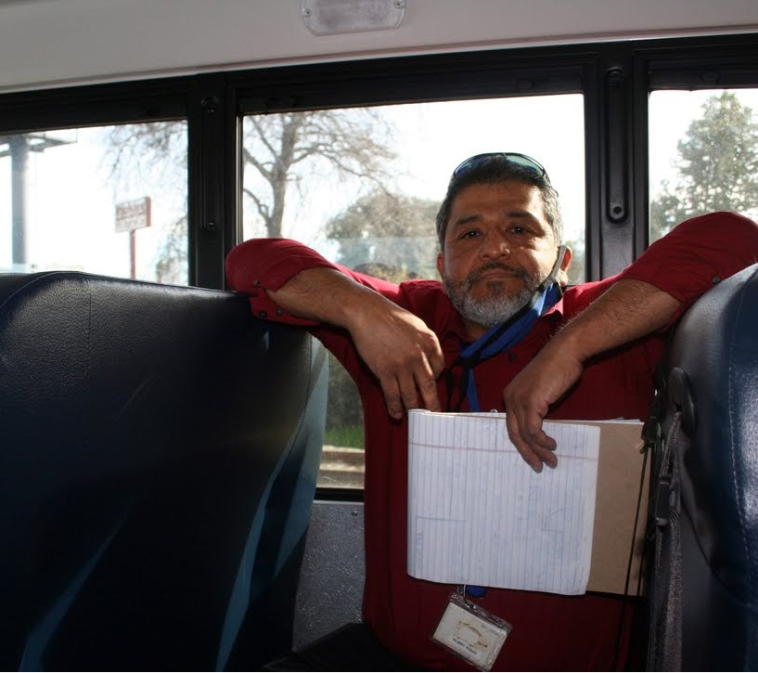
“Zero-emission buses are a symbol of hope and a means of change for communities like Stockton,” says Rosas. “Stockton has shown how a disadvantaged community can go from design to construction to electric school buses in less than a year. I’m sharing Stockton’s story and lessons to help create a future in which communities across the country can make their electric school bus dream a reality.”
“Zero-emission buses are a symbol of hope and a means of change for communities like Stockton,” says Rosas.
Additional Information and Resources:
- California Clean Mobility in Schools Project
- California Community Air Protection Program
- California Low Carbon Transportation Investments and the Air Quality Improvement Program
- California Energy Commission School Bus Replacement Program
- Clean Mobility Options Voucher Pilot Program
- San Joaquin Valley Air Pollution Control District Community Emission Reduction Programs
Want to learn more from the Electric School Bus Series? Explore more stories here.